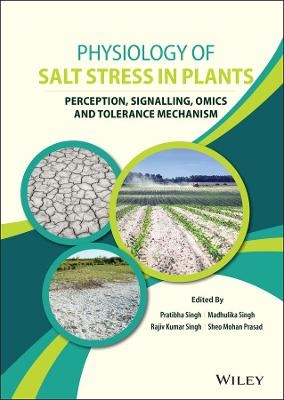
Physiology of Salt Stress in Plants
John Wiley & Sons Inc (Verlag)
978-1-119-70047-0 (ISBN)
In Physiology of Salt Stress in Plants, an editorial team of internationally renowned researchers delivers an extensive exploration of the problem of soil salinity in modern agricultural practices. It also discusses the social and environmental issues caused by salt stress. The book covers the impact of salt on soil microorganisms, crops, and other plants, and presents that information alongside examinations of salt’s effects on other organisms, including aquatic fauna, terrestrial animals, and human beings.
Physiology of Salt Stress in Plants describes the morphological, anatomical, physiological, and biochemical dimensions of increasing soil salinity. It also discusses potential remedies and encourages further thought and exploration of this issue. Readers are encouraged to consider less hazardous fertilizers and pesticides, to use safer doses, and to explore and work upon salt resistant varieties of plants.
Readers will also benefit from the inclusion of:
Thorough introductions to salt stress perception and toxicity levels and the effects of salt stress on the physiology of crop plants at a cellular level
Explorations of the effects of salt stress on the biochemistry of crop plants and salt ion transporters in crop plants at a cellular level
Practical discussions of salt ion and nutrient interactions in crop plants, including prospective signalling, and the effects of salt stress on the morphology, anatomy, and gene expression of crop plants
An examination of salt stress on soil chemistry and the plant-atmosphere continuum
Perfect for researchers, academics, and students working and studying in the fields of agriculture, botany, entomology, biotechnology, soil science, and plant physiology, Physiology of Salt Stress in Plants will also earn a place on the bookshelves of agronomists, crop scientists, and plant biochemists.
Pratibha Singh, Ranjan Plant Physiology and Biochemistry Laboratory, Department of Botany, University of Allahabad, Prayagraj, Uttar Pradesh, India. Madhulika Singh, Centre of Advanced Studies in Botany, Banaras Hindu University, Varanasi, Uttar Pradesh, India. Rajiv Kumar Singh, Horticultural Scientist, Krishi Vigyan Kendra, Sohaon, Ballia, Uttar Pradesh, India. Sheo Mohan Prasad, Ranjan Plant Physiology and Biochemistry Laboratory, Department of Botany, University of Allahabad, Prayagraj, Uttar Pradesh, India.
List of Contributors xiii
Preface xix
1 An introduction to salt stress perception and toxicity level -Worldwide report at a glance
Atun Roy Choudhury, Neha Singh, Ayushi Gupta and P Sankar Ganesh
1.1 Soil Salinity: An Introduction
1.2 Salt stress perception and current scenario
1.3 Types of salt stress
1.4 Origin of problem
1.5 Salt toxicity level: A worldwide report
1.6 Effect of salt stress on flora and fauna of the ecosystem
1.7 Role in sustainable agriculture
1.8 Unintended effects of salt-containing substance application in agricultural land
1.9 Role of salt toxicity in operation of green revolution
1.10 Reaching the current status and conclusion
References
2 Effects of salt stress on physiology of crop plants: At cellular level
Vivekanand Tiwari, Abhay Kumar and Pratibha Singh
2.1 Soil salinity and plants
2.2 Crop loss due to salt toxicity- An estimation worldwide
2.3 Effect of salt stress on target and non-target plants and microorganisms
2.4 Effect of salt stress on physiology of crop plants
2.4.1 Effect of salt stress on chlorophyll biosynthesis, chloroplast functioning and photophosphorylation
2.4.1.1 Chlorophyll biosynthesis in salt stress
2.4.1.2 Salt stress affects chloroplast function
2.4.1.3 Photophosphorylation in salt stress
2.4.2 Glycolysis, Kreb’s cycle enzymes, oxidative phosphorylation, and other mitochondrial functioning
2.4.2.1 Glycolytic pathway in salt stress
2.4.2.2 TCA cycle in salt stress
2.4.2.3 Salt stress and oxidative phosphorylation
2.4.3 Peroxisome functioning
2.5 Halophytes and their physiology
2.5.1 Ion homeostasis in a halophyte
2.5.2 Osmotic adjustment
2.5.3 Physiological and metabolic adaptation of halophytes
2.6 Halophytes in agriculture and land management
2.7 Conclusion and future perspectives
References
3. Effects of salt stress on biochemistry of crop plants
Poonam Yadav and Durgesh Kumar Jaiswal
3.1 Introduction
3.2 Effects of salt stress on lipid metabolism
3.3 Effects of salt stress on amino acid synthesis and nitrogen metabolism
3.4 Effects of salt stress on protein biosynthesis
3.5 Effect of salt stress on oxidation of membrane proteins
3.6 Effect of salt stress on nucleic acid formation
3.7 Binding to DNA and RNA and formation of cross-links
3.8 Effect of salt stress on dephosphorylation of RNA and DNA
3.9 Future advances and conclusion
References
4. Salt ion transporter in crop plant at cellular level
Ria Khare, Gurpreet Sandhu, Aruba Khan, Prateek Jain
4.1 Introduction
4.2 Absorption of Na+ from soil and its compartmentalization in plant cells
4.3 Salt ions regulation in plants cells and tissues
4.4 Role of ion channels and salt ion transporter in crop plants at cellular level
4.5 Transport of Na+ through SOS signal transduction pathway: At cellular level
4.6. Role of salt tolerance responsive genes in transport of Na+ and Cl- ions: At cellular level
4.7 Role of ions in salt stress tolerance
4.8 Reaching the current status and conclusion
References
5. Salt ion and nutrient interactions in crop plants: Prospective signalling
Ria Khare and Prateek Jain
5.1. Introduction
5.2. Effects of salt stress on nutrient absorption
5.3 Effects of salt stress on nutrient cycling in crop plants
5.4 Salt ion and nutrient interactions in crop plants
5.5 Effect of salt stress on nutrient transporters
5.5.1 K transporters
5.5.2 N transporters
5.5.3 P transporters
5.5.4 S transporters
5.6 Role of nutrient interactions: Prospective signalling
5.7 Future prospective and conclusion
References
6. Effects of salt stress on the morphology, anatomy and gene expression of crop plants
Pragati Kumari, Arvind Gupta, Harish Chandra, Pratibha Singh and Saurabh Yadav
6.1 Introduction
6.2 Salt stress and effects on morphology of plants
6.3 Photosynthetic pigments and osmolytes accumulation
6.4 Effect of saline stress on floral organs
6.5 Anatomical features and salt stress
6.6 Yield and related traits
6.7 Salt stress and its effects on Gene expression
6.8 Conclusion
References
7. Effect of salt stress on soil chemistry and plant-atmosphere continuum (SPAC)
Gunjan Goyal, Aruna Yadav and Gunjan Dubey
7.1 Introduction
7.2 Effect of salt stress on soil component
7.2.1 Effect of salt stress on abiotic component of soil and soil health
7.2.2 Effects of salt stress on biotic component of soil and soil health
7.3 Soil chemistry affecting factors in agricultural land
7.4 Soil salinity effect on crop plants
7.4.1 Germination
7.4.2 Growth
7.4.3 Photosynthesis and photosynthetic pigments
7.4.4 Mineral uptake and assimilation
7.4.5 Oxidative stress
7.4.6 Yield
7.5 An introduction to Soil plant-atmosphere continuum (SPAC)
7.6 Salt absorption by roots tissues and their effect on plant-atmosphere continuum (SPAC)
7.7 Translocation of salt ions in the vascular system of crop plants
7.7.1 Mechanism of sodium influx into cytosol
7.7.2 Mechanism of Na+ compartmentalization in vacuoles
7.7.3 The SOS pathway
7.7.4 Effect of salt stress on Xylem transport
7.7.5 Effect of salt stress on Phloem loading
7.8 Current status and conclusion
Acknowledgement
References
8 Effects of salt stress on nutrient cycle and uptake of crop plants
Lav Kumar Jaiswal, Prabhakar Singh, Rakesh Kumar Singh, Tanamyee Nayak, Ankush Gupta
8.1 Introduction
8.2 Limitation of nutrient cycle and uptake of nutrients
8.2.1 Phosphorus limitation
8.2.2 Nitrogen limitation
8.3 Nutrient cycle or Biogeochemical cycle
8.3.1 Water cycle or Hydrological cycle
8.3.2 Carbon cycle
8.3.3 Nitrogen cycle
8.3.4 Oxygen cycle
8.3.5 Phosphorus cycle
8.3.6 Sulfur cycle
8.3.7 Calcium cycle
8.4 Effect of salt stress on carbon cycle
8.5 Effect of salt stress on oxygen and water cycle
8.5.1 Effect of salt stress on oxygen cycle
8.5.2 Effect of salt stress on water cycle
8.6 Effect of salt stress on nitrogen fixing bacteria and biogeochemical cycle of nitrogen
8.7 Effect of salt stress on phosphorus bacteria and biogeochemical cycle of phosphorus
8.8 Effect of salt stress on sulphur bacteria and biogeochemical cycle of sulphur
8.9 Future prospective and conclusion
References
9 Salt induced effects on crop plants and counteract mitigating strategy by antioxidants system
Indrajeet Kumar, Umesh Kumar, Prince Kumar Singh, Rajesh Kumar Sharma
9.1 Introduction
9.2 Formation of salt induced indirect products (oxidative biomarkers) in crops
9.3 Effect of salt stress on crop plants
9.4 Consequences effect of oxidative biomarkers in crop plants
9.4.1 Lipid peroxidation
9.4.2 Effect on Proteins
9.4.3 Effects on Carbohydrates
9.4.4 Effect on polynucleic acids
9.5 Generation of self-defence mitigating strategy in crop plants
9.5.1 Counteract mitigating strategy by enzymatic antioxidants system
9.5.1.1 Superoxide dismutase (SOD)
9.5.1.2 Catalase (CAT)
9.5.1.3 Ascorbate-Glutathione (AsA-GSH) Cycle Enzymes
9.5.1.4 Ascorbate Peroxidases (APX)
9.5.1.5 Monodehydroascorbate reductase (MDHAR) and dehydroascorbate reductase (DHAR)
9.5.1.6 Glutathione Reductase (GR)
9.5.1.7 Guaiacol peroxidase (GPOX)
9.5.2 Counteract mitigating strategy by non-enzymatic antioxidants system
9.6 Conclusion and Future prospective
References
10 Effects of salt stress on osmolyte metabolism of crop plants and mitigating strategy by osmolyte
Abreeq Fatima, Garima Singh, Anuradha Patel, Sanjesh Tiwari, Divya Gupta, Anurag Dubey, Dilip Kumar Prajapati and Sheo Mohan Prasad
10.1 Introduction
10.2 Groups and biosynthetic pathways of osmolytes in crop plant
10.2.1 Polyamines and biosynthetic pathways in the cell organelles of crop plant
10.2.2 Betaeine and their biosynthetic pathways in the cell organelles of crop plant
10.2.3 The biosynthetic pathway of carbohydrate sugar, sugar alcohol and amino acids in the cell organelles of crop plant
10.3 Effect of salt stress on osmolyte production and work action
10.4 The osmotic and ionic adjustment under salt stress; tolerance mechanism
10.5 Conclusion
References
11 Salt stress toxicity amelioration by phytohormone, synthetic products and nutrient amendment practices
Divya Gupta, Garima Singh, Sanjesh Tiwari, Anuradha Patel, Abreeq Fatima Anurag Dudey, Neha Naaz, Jitendra Pandey and Sheo Mohan Prasad
11.1 Introduction
11.2 Structure and mechanism of action of phytohormones under salt stress
11.3 Structural, physiological and biochemical nature of phytohormones under salt stress
11.3.1 Abscisic acid (ABA)
11.3.2 Cytokinins (CKs)
11.3.3 Gibberellins (GAs)
11.3.4 Auxins (AUXs)
11.3.5 Brassinosteroids (BRs)
11.3.6 Salicylic acid (SA)
11.3.7 Jasmonic acid (JA)
11.4 Salt stress toxicity amelioration by exogenous / endogenous phytohormones
11.4.1 Auxin
11.4.2 Gibberellins
11.4.3 Cytokinin
11.4.4 Brassinosteroids
11.4.5 Salicylic acid
11.5 Salt toxicity amelioration by exogenous synthetic products
11.6 Salt toxicity amelioration by exogenous nutrient amendment practices
11.7 Future prospective and conclusion
References
12 Crop plants develop extracellular signalling products against salt stress
Santwana Tiwari, Nidhi Verma, Shikha Singh, Shivam Gupta, Jitendra Pandey and Sheo Mohan Prasad
12.1 Introduction
12.2 Site of synthesis of extracellular signaling products
12.3 Release of extracellular products by cells of cyanobacteria, algae and crop plant under salt stress: antioxidants, enzymes and proteins
12.3.1 Antioxidants
12.3.2 Enzymes
12.3.3 Proteins
12.4 Release of extracellular products by cells of cyanobacteria, algae and crop plants under salt stress: amino acids, osmolytes, nitrogen, nitric oxide, ammonia
12.4.1 Amino acids
12.4.2 Osmolytes
12.4.3 Nitrogen and its derivatives
12.5 Release of extracellular products by cells of cyanobacteria and crop plants under salt stress: phytols, sterols, terpenoid, fatty acids, phenols
12.5.1 Phenols
12.5.2 Terpenoids
12.5.3 Phytols
12.5.4 Sterols
12.5.5 Fatty Acids
12.6 Release of extracellular products by cells of cyanobacteria and crop plants under salt stress: Photoprotective compounds, polysaccharides, halogenated compounds and phytohormones
12.6.1 Photoprotective compounds
12.6.2 Polysaccharides and halogenated compounds
12.7 Uncovering potential and applications of extracellular signaling products in biology, agriculture and medicine
12.8 Current status and future prospects
References
| Erscheinungsdatum | 12.10.2021 |
|---|---|
| Verlagsort | New York |
| Sprache | englisch |
| Maße | 170 x 244 mm |
| Gewicht | 680 g |
| Themenwelt | Naturwissenschaften ► Biologie ► Allgemeines / Lexika |
| Weitere Fachgebiete ► Land- / Forstwirtschaft / Fischerei | |
| ISBN-10 | 1-119-70047-7 / 1119700477 |
| ISBN-13 | 978-1-119-70047-0 / 9781119700470 |
| Zustand | Neuware |
| Informationen gemäß Produktsicherheitsverordnung (GPSR) | |
| Haben Sie eine Frage zum Produkt? |
aus dem Bereich


